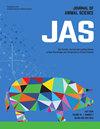饲料中添加银饲料植物提取物对放牧内生菌感染的高羊茅的小母牛生产性能和健康的影响
IF 2.9
2区 农林科学
Q1 AGRICULTURE, DAIRY & ANIMAL SCIENCE
引用次数: 0
摘要
添加植物提取物可以改善牛放牧内生菌感染(E+)毒性高羊茅的动物健康状况和生产性能。目的是评估饲料中添加银饲料植物提取物对小母牛生产性能的影响,以及与羊茅中毒和疫苗反应相关的生理指标。试验期开始前,选取44头1龄小母牛(292.6±29.0 kg)作为单组饲喂E+高羊茅。将小母牛分为3个处理组:1)E+黄豆皮牧场(SH);n = 3个牧场),2)E+添加大豆皮和BX添加剂的牧场(BX;每天每头小母牛10克;n = 3个牧场),3)添加大豆皮和ATX添加剂(ATX;5克/头母牛每日;N = 3个牧场)。试验于4月至6月进行为期84 d的处理,按1.8 kg/母牛/日饲喂。分别在第0、28、56和84天记录相对于处理期开始时的小母牛体重和毛毛评分。在第56天接种改良的BRD多价活疫苗,并于第0、14和28天采集相对于疫苗接种的血清样本。用比色法分析第56天采集的血尿素氮(BUN)。第84天采集血清催乳素,用放射免疫分析法进行分析。使用r的LME4软件包对小母牛体重、平均日增重、毛被评分和BHV-1滴度进行两两比较,使用r的EMMEANS软件包进行两两比较,将第0天的数据作为协变量,其中牧场块作为随机效应。血清催乳素和BUN采用SAS混合程序分析,治疗为固定效应,阻断为随机效应。在84 d的处理期内,小母牛体重(P≥0.1)、毛被评分(P≥0.1)和平均日增重(P = 0.40)各组间无显著差异。然而,在第56 ~ 84天,相对于仅饲喂SH (0.23 kg/d)的母牛,ATX组的平均日增重(0.53 kg/d)和体重(0.49 kg/d)有增加趋势(P = 0.07)。治疗对BHV-1滴度无影响(P≥0.1)。两组血清催乳素(P = 0.97)和BUN (P = 0.38)差异无统计学意义。初步结果显示有可能改善体重增加,这表明有必要进行更多实验单位的进一步研究。本文章由计算机程序翻译,如有差异,请以英文原文为准。
166 Effects of dietary inclusion of Silvafeed plant extract supplements on performance and health of heifers grazing endophyte-infected tall fescue
Supplemental plant extracts may improve animal health status and performance of cattle grazing endophyte-infected (E+) toxic tall fescue. The objective was to assess dietary inclusion of Silvafeed plant extracts on heifer performance and physiological measures associated with fescue toxicosis and vaccine response. A total of 44 yearling heifers (292.6 ± 29.0 kg) were maintained as a single group on E+ tall fescue prior to the start of the treatment period. Heifers were assigned to one of three treatment groups: 1) E+ pastures with soybean hulls (SH; n = 3 pastures), 2) E+ pastures with soybean hulls and BX additive (BX; 10 g/heifer daily; n = 3 pastures), and 3) E+ pastures with soybean hulls and ATX additive (ATX; 5 g/heifer daily; n = 3 pastures). Treatments were administered over an 84-d period between April and June and offered as-fed at 1.8 kg/heifer daily. Heifer body weight and hair coat scores were recorded on d 0, 28, 56, and 84 relative to the start of the treatment period. On d 56, heifers received a modified live multivalent BRD vaccine and serum samples were collected on d 0, 14, and 28 relative to vaccination. Samples for blood urea nitrogen (BUN) collected on d 56 were analyzed by colorimetric methods. Serum prolactin collected on d 84 was analyzed by radioimmunoassay. Heifer body weight, average daily gain (ADG), hair coat scores, and BHV-1 titers were analyzed using the LME4 package of R. Pairwise comparisons were conducted using the EMMEANS package of R. Data from d 0 was used as a covariate with pasture block included as a random effect. Serum prolactin and BUN were analyzed using the MIXED procedure of SAS with treatment as a fixed effect and block as a random effect. Heifer body weight (P ≥ 0.1), hair coat scores (P ≥ 0.1), and ADG (P = 0.40) did not differ between treatments over the 84-d treatment period. However, there was a tendency for an increase in ADG of heifers receiving ATX (0.53 kg/d) and BX (0.49 kg/d) relative to heifers receiving SH only (0.23 kg/d) between d 56 and d 84 (P = 0.07). There was no impact of treatment on BHV-1 titers (P ≥ 0.1). Serum prolactin (P = 0.97) and BUN (P = 0.38) did not differ between treatments. Preliminary results show the potential for improved weight gain, suggesting further investigation with more experimental units is warranted.
求助全文
通过发布文献求助,成功后即可免费获取论文全文。
去求助
来源期刊

Journal of animal science
农林科学-奶制品与动物科学
CiteScore
4.80
自引率
12.10%
发文量
1589
审稿时长
3 months
期刊介绍:
The Journal of Animal Science (JAS) is the premier journal for animal science and serves as the leading source of new knowledge and perspective in this area. JAS publishes more than 500 fully reviewed research articles, invited reviews, technical notes, and letters to the editor each year.
Articles published in JAS encompass a broad range of research topics in animal production and fundamental aspects of genetics, nutrition, physiology, and preparation and utilization of animal products. Articles typically report research with beef cattle, companion animals, goats, horses, pigs, and sheep; however, studies involving other farm animals, aquatic and wildlife species, and laboratory animal species that address fundamental questions related to livestock and companion animal biology will be considered for publication.
 求助内容:
求助内容: 应助结果提醒方式:
应助结果提醒方式:


